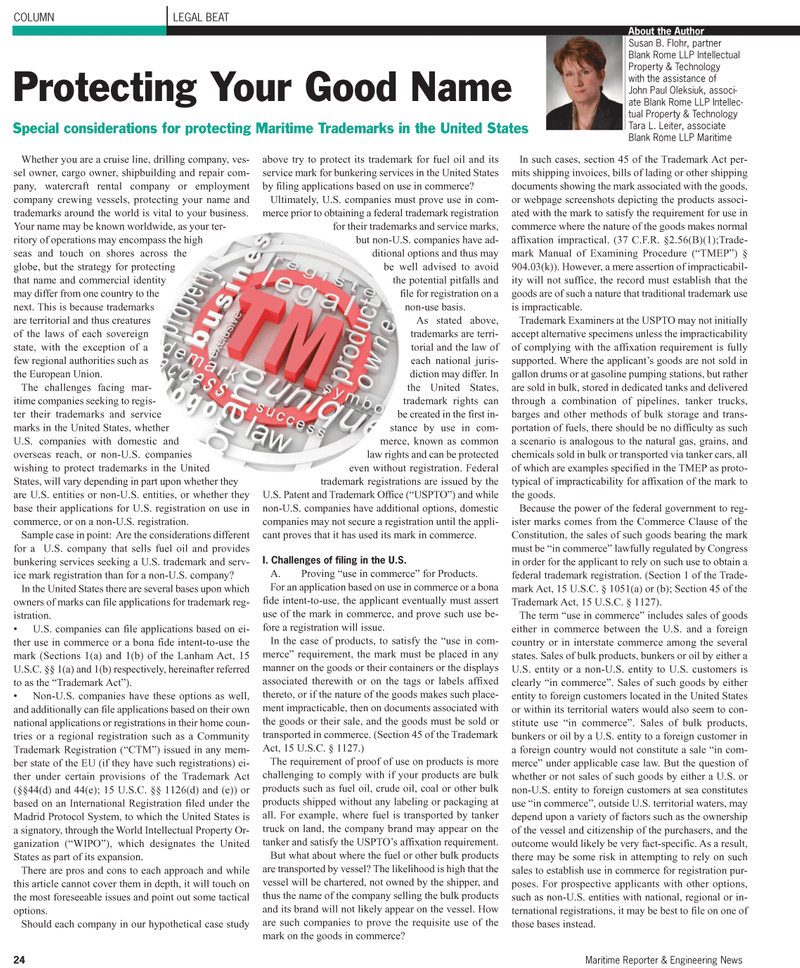
Page 24: of Maritime Reporter Magazine (February 2011)
Cruise & Passenger Vessel Annual
Read this page in Pdf, Flash or Html5 edition of February 2011 Maritime Reporter Magazine
24 Maritime Reporter & Engineering News
Whether you are a cruise line, drilling company, ves- sel owner, cargo owner, shipbuilding and repair com- pany, watercraft rental company or employment company crewing vessels, protecting your name and trademarks around the world is vital to your business.
Your name may be known worldwide, as your ter- ritory of operations may encompass the high seas and touch on shores across the globe, but the strategy for protecting that name and commercial identity may differ from one country to the next. This is because trademarks are territorial and thus creatures of the laws of each sovereign state, with the exception of a few regional authorities such as the European Union.
The challenges facing mar- itime companies seeking to regis- ter their trademarks and service marks in the United States, whether
U.S. companies with domestic and overseas reach, or non-U.S. companies wishing to protect trademarks in the United
States, will vary depending in part upon whether they are U.S. entities or non-U.S. entities, or whether they base their applications for U.S. registration on use in commerce, or on a non-U.S. registration.
Sample case in point: Are the considerations different for a U.S. company that sells fuel oil and provides bunkering services seeking a U.S. trademark and serv- ice mark registration than for a non-U.S. company?
In the United States there are several bases upon which owners of marks can file applications for trademark reg- istration. • U.S. companies can file applications based on ei- ther use in commerce or a bona fide intent-to-use the mark (Sections 1(a) and 1(b) of the Lanham Act, 15
U.S.C. §§ 1(a) and 1(b) respectively, hereinafter referred to as the “Trademark Act”). • Non-U.S. companies have these options as well, and additionally can file applications based on their own national applications or registrations in their home coun- tries or a regional registration such as a Community
Trademark Registration (“CTM”) issued in any mem- ber state of the EU (if they have such registrations) ei- ther under certain provisions of the Trademark Act (§§44(d) and 44(e); 15 U.S.C. §§ 1126(d) and (e)) or based on an International Registration filed under the
Madrid Protocol System, to which the United States is a signatory, through the World Intellectual Property Or- ganization (“WIPO”), which designates the United
States as part of its expansion.
There are pros and cons to each approach and while this article cannot cover them in depth, it will touch on the most foreseeable issues and point out some tactical options.
Should each company in our hypothetical case study above try to protect its trademark for fuel oil and its service mark for bunkering services in the United States by filing applications based on use in commerce?
Ultimately, U.S. companies must prove use in com- merce prior to obtaining a federal trademark registration for their trademarks and service marks, but non-U.S. companies have ad- ditional options and thus may be well advised to avoid the potential pitfalls and file for registration on a non-use basis.
As stated above, trademarks are terri- torial and the law of each national juris- diction may differ. In the United States, trademark rights can be created in the first in- stance by use in com- merce, known as common law rights and can be protected even without registration. Federal trademark registrations are issued by the
U.S. Patent and Trademark Office (“USPTO”) and while non-U.S. companies have additional options, domestic companies may not secure a registration until the appli- cant proves that it has used its mark in commerce.
I. Challenges of filing in the U.S.
A. Proving “use in commerce” for Products.
For an application based on use in commerce or a bona fide intent-to-use, the applicant eventually must assert use of the mark in commerce, and prove such use be- fore a registration will issue.
In the case of products, to satisfy the “use in com- merce” requirement, the mark must be placed in any manner on the goods or their containers or the displays associated therewith or on the tags or labels affixed thereto, or if the nature of the goods makes such place- ment impracticable, then on documents associated with the goods or their sale, and the goods must be sold or transported in commerce. (Section 45 of the Trademark
Act, 15 U.S.C. § 1127.)
The requirement of proof of use on products is more challenging to comply with if your products are bulk products such as fuel oil, crude oil, coal or other bulk products shipped without any labeling or packaging at all. For example, where fuel is transported by tanker truck on land, the company brand may appear on the tanker and satisfy the USPTO’s affixation requirement.
But what about where the fuel or other bulk products are transported by vessel? The likelihood is high that the vessel will be chartered, not owned by the shipper, and thus the name of the company selling the bulk products and its brand will not likely appear on the vessel. How are such companies to prove the requisite use of the mark on the goods in commerce?
In such cases, section 45 of the Trademark Act per- mits shipping invoices, bills of lading or other shipping documents showing the mark associated with the goods, or webpage screenshots depicting the products associ- ated with the mark to satisfy the requirement for use in commerce where the nature of the goods makes normal affixation impractical. (37 C.F.R. §2.56(B)(1);Trade- mark Manual of Examining Procedure (“TMEP”) § 904.03(k)). However, a mere assertion of impracticabil- ity will not suffice, the record must establish that the goods are of such a nature that traditional trademark use is impracticable.
Trademark Examiners at the USPTO may not initially accept alternative specimens unless the impracticability of complying with the affixation requirement is fully supported. Where the applicant’s goods are not sold in gallon drums or at gasoline pumping stations, but rather are sold in bulk, stored in dedicated tanks and delivered through a combination of pipelines, tanker trucks, barges and other methods of bulk storage and trans- portation of fuels, there should be no difficulty as such a scenario is analogous to the natural gas, grains, and chemicals sold in bulk or transported via tanker cars, all of which are examples specified in the TMEP as proto- typical of impracticability for affixation of the mark to the goods.
Because the power of the federal government to reg- ister marks comes from the Commerce Clause of the
Constitution, the sales of such goods bearing the mark must be “in commerce” lawfully regulated by Congress in order for the applicant to rely on such use to obtain a federal trademark registration. (Section 1 of the Trade- mark Act, 15 U.S.C. § 1051(a) or (b); Section 45 of the
Trademark Act, 15 U.S.C. § 1127).
The term “use in commerce” includes sales of goods either in commerce between the U.S. and a foreign country or in interstate commerce among the several states. Sales of bulk products, bunkers or oil by either a
U.S. entity or a non-U.S. entity to U.S. customers is clearly “in commerce”. Sales of such goods by either entity to foreign customers located in the United States or within its territorial waters would also seem to con- stitute use “in commerce”. Sales of bulk products, bunkers or oil by a U.S. entity to a foreign customer in a foreign country would not constitute a sale “in com- merce” under applicable case law. But the question of whether or not sales of such goods by either a U.S. or non-U.S. entity to foreign customers at sea constitutes use “in commerce”, outside U.S. territorial waters, may depend upon a variety of factors such as the ownership of the vessel and citizenship of the purchasers, and the outcome would likely be very fact-specific. As a result, there may be some risk in attempting to rely on such sales to establish use in commerce for registration pur- poses. For prospective applicants with other options, such as non-U.S. entities with national, regional or in- ternational registrations, it may be best to file on one of those bases instead.
COLUMN LEGAL BEAT
Protecting Your Good Name
Special considerations for protecting Maritime Trademarks in the United States
About the Author
Susan B. Flohr, partner
Blank Rome LLP Intellectual
Property & Technology with the assistance of
John Paul Oleksiuk, associ- ate Blank Rome LLP Intellec- tual Property & Technology
Tara L. Leiter, associate
Blank Rome LLP Maritime

 23
23

 25
25
